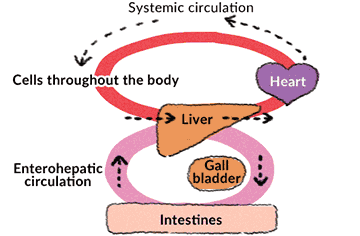Liver cirrhosis nutritional therapy


The liver is a very important organ that performs a number of essential functions for the body.
Because of this, it is the heaviest organ, weighing from 1.2kg to 1.5kg in adults. If the liver becomes damaged by liver cirrhosis and its fuctionality impaired, it can cause various disorders, not only within the liver itself but throughout the body.
Amongst the liver's various functions, the metabolization and storage of nutrients is the most important. Nutrients that are consumed through food cannot be used in the body as they are, but need to be transformed into a usable form in the liver.
- What is liver cirrhosis?
- If viral hepatitis or alcoholic liver disease continue for an extended period of time, and impact the functioning of the liver, symptoms of jaundice, swelling, abdominal dropsy, and hepatic encephalopathy may develop.
Also, blood vessels may dilate due to fibrosis of the liver cells, causing increased portal pressure (pressure on the blood vessel that carries blood to the liver), which can in turn lead to gastroesophageal varices, splenoma, and thrombopenia. The phase before the development of symptoms is called "compensated cirrhosis," while the phase with jaundice, abdominal dropsy, hepatic encephalopathy, and other conditions is called "decompensated" cirrhosis.
Food that has been ingested is broken into glucose, amino acids, fatty acids, and other substances in the stomach and small intestine before being transported through the blood stream to the liver.
The nutrients that enter the liver are resynthesized into a variety of substances that are necessary for the body, such as glycogen and albumin.
Hepatitis occurs when the liver is infected by the hepatitis B virus or hepatitis C virus.
In addition to viruses, liver disease can also be caused by alcohol, excessive eating, immune disorders, and drugs.
Because malnutrition (becoming extremely thin, decreased skeletal muscle mass) inhibits recovery from liver cirrhosis and impacts quality of life, to improve the function of the liver it is important to increase food intake, get appropriate exercise, and if necessary, eat a light meal before bedtime. As a form of medical treatment, branch-chained amino acids (BCAA) etc are administered.
Learn more about liver cirrhosis
Editorial supervisor: Nagisa Hara, Assistant Professor, Liver Center, Saga University Hospital
Consult your doctor, pharmacist, or nutritionist about your daily intake of protein and calories.
2017 DEC EN1712044
- Protect Yourself From Heat Disorders
- Preventing Traveller's Thrombosis (Economy Class Syndrome)
- Menopause lab (Japanese)
- Living well with menopause
- PMS lab (Japanese)
- men-eki navi (website about "immunity", in Japanese only)
- AMP helps the renewal of skin cells (Japanese)
- Sleep Rhythm Lab (Japanese)
- The surprising facts about dietary fiber
- Everything You Need to Know about GI
- Jump start your brain with a well-balanced breakfast
- Vitamins & Minerals Q&A
- BCAA Helps Maintain Exercise Performance
- Smile Navigator: Schizophrenia (Japanese)
- Smile Navigator: Bipolar disorder (Japanese)
- Smile Navigator: Depression (Japanese)
- Smile Navigator: Pediatric autism spectrum disorder (Japanese)
- Zutsuu-nayami.jp (website about "headaches", in Japanese only)
- Parkinson's Disease
- Restless Legs Syndrome
- Gen-shu.jp ("reducing alcohol consumption", in Japanese only)
- Learn about Heart Failure, its Prevention, and Treatment
- ADPKD.JP (Japanese)
- PAD: Be Careful of Changes in Your Limbs
- Liver cirrhosis nutritional therapy
- Get Your Healthy Stomach Back
- Did You Know There Are Quick Tests for Infectious Diseases?
- Do You Have Symptoms of Dry Eye?
- Decoboco eye: All about eye health (Japanese)
- Atopeace (website about "atopic dermatitis", in Japanese only)
- Acne: Are You Doing Anything About It?





